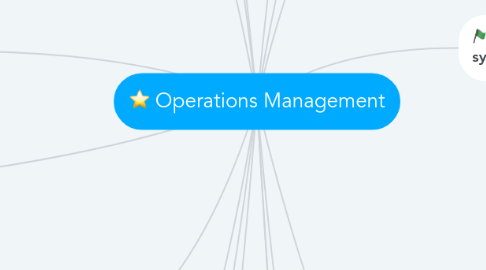
1. Repite el proceso
2. Topic 3. Inventory model
2.1. Discounts per quantity
2.1.1. discrete change
3. Topic 4. MRP
3.1. Material requirement
3.1.1. Sales department
3.1.2. Finances
3.1.3. Management
3.1.4. Manufacturing
3.2. lot per lot rule
3.2.1. planned orders,
3.3. EOQ model
3.3.1. preparation and retention costs.
4. Topic 5. Basic concepts of the CRP, MRP and MPS
4.1. CRP
4.1.1. capacity analysis
4.2. MRP
4.2.1. material requirements
4.2.1.1. long-term
4.2.1.2. mid-term
4.2.1.3. mid-term
4.2.1.4. short-term
5. Topic 7. OPT
5.1. theory of constraints
5.1.1. Throughput:
5.1.2. Inventories
5.1.3. Operational expenses
5.2. Theory of Constraints
5.2.1. Drummer,
5.2.2. Buffer
5.2.3. Rope
5.2.4. restriction capacity
6. Topic 9. Project management
6.1. CPM
6.1.1. Choose a company.
6.1.2. annual report
6.1.3. technical data
6.1.4. obtained information
6.1.5. decision
6.2. critical path,
6.3. PERT
6.3.1. time estimates
6.3.1.1. GANTT
7. Topic 11. Aggregate planning optimization and disaggregation of a MPS
7.1. PL
7.1.1. mathematical techniques
7.1.2. basic conditions
7.1.2.1. Limited resources
7.1.2.2. Explicit goal.
7.1.2.3. Linearity
7.1.2.4. Homogeneity
7.1.2.5. Divisibility
8. Topic 13. Definition of heuristic methods and limitations of jobs sequencing
8.1. programming systems
8.1.1. Infinite load
8.1.1.1. assigned to a work center
8.1.2. Finite load.
8.1.2.1. production and preparation
8.1.3. Forward scheduling
8.1.3.1. system takes an order and programs all the operations
8.1.4. Backwards scheduling
8.1.4.1. required operations
9. Topic 15. Line balancing
9.1. basic principles
9.1.1. distancia mínima
9.1.2. workflow
9.1.3. work division
9.1.4. simultaneity
9.1.5. fixed path
9.1.6. minimum time and the material in process
9.1.7. exchangeability
9.2. balancing criteria
9.2.1. Bottleneck.
9.2.2. Operation standard time
9.2.3. Takt time.
9.2.4. Scheduled cycle time.
9.2.5. Operator cycle time
9.2.6. Lead time.
10. make JIT
11. Topic 1. Importance and relevant costs on inventory control
11.1. Inventories background
11.1.1. Independence operations.
11.1.2. Change in demand
11.1.3. Flexibility in the production
11.1.4. Protected in the raw material
11.2. Strategic planning and inventory decisions
11.2.1. Cost
11.2.2. Quality
11.2.3. Delivery speed
11.2.4. Reliability on delivery
11.2.5. Changes in demand
11.2.6. Speed to introduce new products
11.3. Costs involved and inventory costing
11.3.1. Cost of inventory transportation
11.3.2. Discounts based on the order
11.3.3. Cost of inventory
11.3.4. Costs of preparation or production
12. Topic 2. Size of the economic quantity
12.1. Inventory systems
12.1.1. Fixed order quantity
12.1.1.1. EOQ and Q model
12.1.2. Fixed period
12.1.2.1. interval , and P model
13. Topic 6. JIT
13.1. Strategies
13.1.1. Reduce cost
13.1.2. Immediate response
13.1.3. more reliable
13.2. Kanban
13.2.1. adjusts the flows
14. Topic 8. Production control system
14.1. production plan
14.1.1. Market demand
14.1.2. Inventory levels
14.1.3. Economic conditions
14.1.4. Competitors behavior
14.2. control functions
14.2.1. actual demand
14.2.2. economic values
14.2.3. production necessities
14.2.4. stock levels
14.2.5. production distribution
15. Topic 10. Aggregate planning elements: graphics and charts
15.1. workforce variation
15.1.1. aggregate plan
15.1.1.1. establishing the production
15.1.2. different for each company,
16. Topic 12. Networks with probabilistic timing and project shortening
16.1. PERT
16.1.1. Combination of activities
16.1.2. Sequential relation
16.1.3. Time concerns
16.1.4. Resources concerns
16.2. Time
16.2.1. Optimistic
16.2.2. Likely
16.2.3. Pessimistic
16.3. CPM
16.3.1. Time and normal cost
16.3.2. Time and intensive cost
16.3.3. types of costs
16.3.3.1. Direct costs
16.3.3.2. Indirect costs:
17. Topic 14. Stochastic models for jobs sequencing
17.1. multi-period uncertainty
17.1.1. Predict the results
17.1.2. estrategias alternativas
17.1.3. Determine
17.1.3.1. Dimension
17.1.3.2. Control
17.1.3.3. Service level
17.1.3.4. Delay

